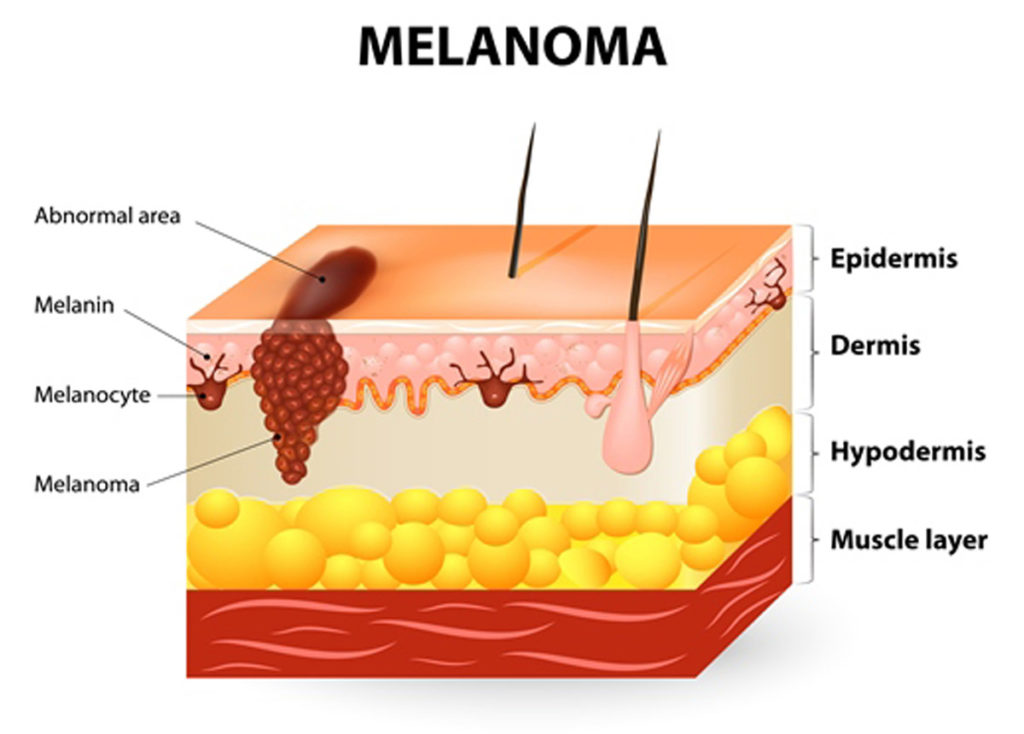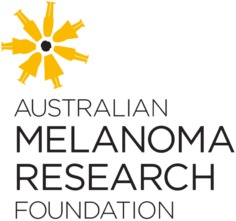What is melanoma?
Melanoma is one of the three main types of skin cancer and begins in the cells of the skin called melanocytes. Melanocytes produce a dark pigment (melanin) which helps protect the deeper layers of the skin from ultra violet radiation (eg. sunlight).
The amount of pigment that is produced varies with skin type. Darker skin tonings give greater protection from the sun however even darker skinned people can still get melanoma. It is when the melanocytes produce melanin in an unregulated or uncontrolled way that melanoma can develop.
As a melanoma begins to grow it is initially confined to the top layers of the skin, however, if left untreated can spread quickly through the deeper layers where it can then enter the lymphatic system or blood stream and travel to almost any part of the body, especially the lymph nodes, lungs, liver, brain and other areas of the skin. It is particularly dangerous when this spread occurs, and if surgery is not possible or is unsuccessful, the melanoma quickly becomes life threatening.
Melanoma can also arise on areas of the skin that are not exposed to the sun.

Development of melanoma
Ultra-violet (UV) radiation from sunlight (and tanning beds) plays a very important role in the development of melanoma and other skin cancers. Research has found that the rates of melanoma in Australia are higher near the coastline and it is reasoned that this is due to lifestyle factors, outdoor activity and greater sun exposure. The rates are also higher in Australia’s northern states due to the greater intensity of the sun.
Types of melanoma
Superficial Spreading Melanoma
Accounts for approx 70% of all diagnosed melanomas. It usually occurs in a previously non cancerous mole and is most commonly found on the trunk and back in men and on the legs and back of women. In the early stages it may look like a freckle or mole that is spreading sideways. Over time it can change in colour, itch or develop irregular borders. It can progress rapidly!
Nodular Melanoma
Accounting for around 15% of diagnosed melanomas, it is also the most aggressive. It may appear where a mole or lesion did not exist before. They tend to be darkly pigmented and spread rapidly in depth.
Acral Lentiginous Melanoma
Also called Subungual melanoma only accounts for around 5% of melanomas but makes up 50% of melanomas in those with dark skin. Most commonly found on the palms of the hands, soles of the feet or under finger and toe nails. In the early stages it is often mistaken for a bruise, blood blister or streak in the nail.
Lentigo Maligna Melanoma
Accounts for around 10% of melanomas and often occurs on the face of middle aged to elderly persons who have suffered sun damage. For this reason it often mistaken for sunspots and goes undiagnosed or untreated making it very dangerous. It often has very irregular borders and varying shades of brown or black.
Amelanotic Melanoma
Literally means “without melanin”, which is what gives other melanomas their darker colour. Hence, these melanomas are often misdiagnosed or there is a delay in patients seeking treatment. They can appear as a lesion with little or no colour, pink or scar looking. Any lesion that is scar like or appears next to a previously treated melanoma should be examined immediately.
Ocular/Uveal Melanoma
Ocular/Uveal Melanoma is a rare and often aggressive type of melanoma that can arise within the eye. It arises from the melanocytes that give the eye its colour. The exact cause is unknown but risk factors include increased exposure to ultraviolet radiation, having light coloured eyes and being of Caucasian descent. Symptoms of an ocular melanoma tumour can include blurred vision, flashing lights and shadows. However it is not uncommon for a patient to experience no symptoms and be diagnosed during a routine eye check. The best strategy for prevention of ocular/uveal melanoma is to wear UV protective sunglasses and a broad brimmed hat.
Mucosal Melanoma
Mucosal Melanoma is also rare and accounts for only 1% of all melanomas. As with the skin, melanocytes are present in the mucosal surfaces of the body which line areas such as the sinuses, oral cavity, vagina, bowel and anus. Unlike melanoma of the skin, mucosal melanoma is not linked to sun/UV exposure. Because of location, many mucosal melanomas go undiagnosed and are often quite advanced once identified.
What to look for
It is very important to check your skin regularly in order to detect any changes in the SIZE, COLOUR or SHAPE of a mole or skin lesion.
An easy way to detect potentially harmful moles or lesions is by using the ABCDE guidlines.
Yes. In fact, everyone is at risk, as we are all exposed to the sun. Due to variations in skin types, some people are more at risk than others.
Prevention
Your exposure to ultra violet (UV) light from the sun is one of the major risk factors for melanoma that you can control. UV levels are highest in summer, late spring and early autumn.
UV levels are not dependent on the temperature or cloud cover. A colder, cloudy day will still have high UV levels in summer. The following tips can help prevent melanoma…
Catching a melanoma in its early stages is one of the most important factors in improving the outcome of a melanoma diagnosis. It can literally SAVE A LIFE.
Why is catching it early so important?
Did you know...
AUSTRALIANS WHO WILL
BE DIAGNOSED WITH
MELANOMA DURING
THEIR LIFETIME
MEN WHO WILL BE
DIAGNOSED WITH
MELANOMA DURING
THEIR LIFETIME
WOMEN WHO WILL BE
DIAGNOSED WITH
MELANOMA DURING
THEIR LIFETIME
IN AUSTRALIA AFTER
PROSTATE & COLORECTAL CANCER (MEN), BREAST
& COLORECTAL
CANCER (WOMEN)
